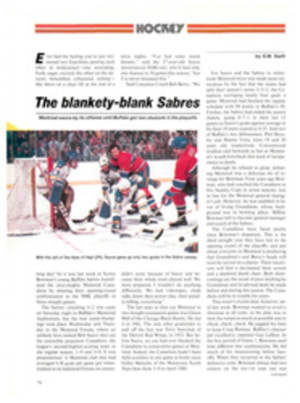
THREE-CUSHION BILLIARDS IS TO POOL WHAT CHESS IS TO CHINESE CHECKERS
When you mention billiards, most people think of pool—eight-ball, nine-ball, call-shot, rotation and the like, which are pocket billiard games. When you mention three-cushion billiards, most people don't have any idea what you're referring to. So, here's what that game is all about:
Three-cushion billiards is played on a pocketless 5- by 10-foot table somewhat larger than a regulation pool table which is 4½ by 9 feet. Only three balls are used in the game. One of them is red, two are white. One of the white balls is marked with a black dot. One player uses the plain white ball as his cue ball throughout a game, while his opponent uses the dotted white ball as his. Each cue ball also doubles as an object ball, and the red one always serves as an object ball. A game may consist of as many points as the opponents agree upon—from fifteen to fifty would be the usual range—and to score a point, or billiard, a player must execute a shot that causes his cue ball to hit three or more cushions and one of the object balls, in any sequence, before it hits the other object ball. There are two basic shots in the game. The carom shot: The cue ball hits an object ball first, then rebounds from three cushions and finally hits the second object ball. The bank shot: The cue ball banks off three cushions first, then bounces off one object ball into the other.
It's no exaggeration to state that anything approaching mastery of the game requires a genuinely creative mind. Every shot a player tries—and there are hundreds of traditional ones—must be accurately planned in the player's mind before it can be successfully executed. Once the proper angles have been reasoned out, they must be accomplished by deftly controlling the speed of the stroke and the spin imparted to the cue ball, techniques which involve both geometry and physics.
Various methods have been devised to help players master the difficulties of the game. One of the most popular is called The 5 System, which is explained thusly in The Master's Book of Pool and Billiards, by Joe Atone (Crown Publishers, Inc.): "If you shoot toward the far end of the table from a specific point, and if you count subdivisions from the far end of the table to the rebound points along both rails, you will discover that the total number of subdivisions equals the number of the point from which the shot was made." Well, sure.
About the only thing left to add to all of this is that the game is by no means as simple as it sounds. While any run-of-the-mill beer hall eight-baller can sink six shots in a row and while the best straight-pool players have runs that number in the hundreds, a run of five is a notable achievement for an experienced three-cushion billiard player. National class competitors occasionally run 10 points, and since the first U.S. tournament, which was held in St. Louis in 1878, no more than half a dozen men have made runs of 20 or more.
My own three-cushion career began 30 years ago in Hawaii when a high school friend and I had a spearfishing trip at Waikiki Beach canceled out by a rainstorm. Even though we weren't members, we walked out to the Elks Club near the tip of Diamond Head. We'd heard that it was an easy place to sneak into and that the pool tables were of excellent quality—not to mention free—so we were hoping to kill the rainy day with some eight-ball.
Instead, we ended up watching two elderly gentlemen at a three-cushion billiard table, which was something neither of us had ever seen, or heard of, before. The winner of the match, who must have been 75, asked us if we'd care to learn the game. "I'd be more than happy to instruct you," he said with a formal bow. "It's nice to see some young members using the club for a change."
So we played with him for an hour or so, and he showed us a sampling of simple shots. After that, we remained for 10 or 12 hours, until the bartender threw us out at closing time. We were fascinated with billiards, and for the next two years I'm sure we put in as much time at it as any of the club's legitimate members. In the summer of 1955, not long before I left Hawaii for college, I was elated when I finally managed a run of three.
Three-cushion billiards is no better known than chalk stream dry fly fishing in many parts of the country, but, as luck would have it, there were a few tables in the student union at the University of Colorado in Boulder. I played there three or four nights a week, sometimes alone, sometimes with a center on the football team named Charlie Scribner. The run of four that I made my junior year was as satisfying as anything I accomplished as an undergraduate.
A few years later, while I was in the Army, my billiards career reached its apex. With about six months to go in my tour, I was transferred from Germany to Fort Ord in Monterey, Calif., where my only duties were cleaning up a company rec room each weekday morning. The day room had been furnished with a billiard table instead of the customary pool table, so after I finished my superficial sweeping and dusting, I was able to practice for several hours a day. A week or two before my discharge I finally made a run of five. When my tour was up, I was almost sorry to leave.
I've played a few games of three-cushion since then, but have never lived where regular play was convenient. And I've missed billiards, though I hadn't realized how much until last fall, when I watched what is purported to be the world's largest tournament. More than 100 shooters from as far away as The Netherlands played for a week at the Elks Club in Medford, Ore.
I drove to Medford for the finals, in which a player named Jim McFarland beat Bill Spadafore even though Spadafore had the tournament's longest run—11. Some of the players I watched were more than 80 and all of them were good.
No other sporting event I've seen has produced anything quite like the dignified, yet exciting atmosphere at that match. Almost every shot provided moments of genuine suspense, usually occurring between the time I realized what a player was trying to do with a shot and the time when it finally succeeded or failed. Everything was, surprisingly, pleasantly quiet. In fact, the players, always concentrating on the table, seldom spoke. Most of their shots were softly hit, the balls rebounding noiselessly from the cushions and clicking when they ricocheted off one another. A good shot by an opponent was acknowledged by four or five raps on the floor with the rubber butt of a cue stick. The referees would almost whisper, "Three for Mr. Spadafore," at the completion of an inning, or, "No billiard," when a player missed a close shot.
I talked to Ron Negless, chairman of the tournament, about the game. "I can't understand why it isn't more popular," he said. "Except that it's so difficult. A world-class player averages a point an inning. On the other hand, it's the difficulty that's attractive. Most of us start at pool and end up wanting more of a challenge. And I don't know of anybody who's gone back to pool again after getting started in this. Sometimes it goes too far. People get irrational. They'll try anything to improve. I know, because it's happened to me. The game takes up so much of my time that I've tried to quit more than once, but I just can't do it permanently. There's so much improvement possible, no matter how good you are. Truth is, billiards becomes an addiction, an obsession. I really think that once you start, it's impossible to give it up. Maybe you can break away for a while, but sooner or later you're bound to come back."
I think Negless knows what he's talking about.
I've already begun trying to talk my wife into letting me buy a billiard table. We have a fairly small house, but I've taken the measurements, and a table could fit in our living room and still leave space for the couch and a chair or two. The state college in town offers classes in geometry and physics. With sufficient effort, I'm sure I'll begin to understand The 5 System, and with three hours of practice a day—certainly no more than four—I'll have chalked up a run of six by 1990 or so.
ILLUSTRATION
DON WELLER

